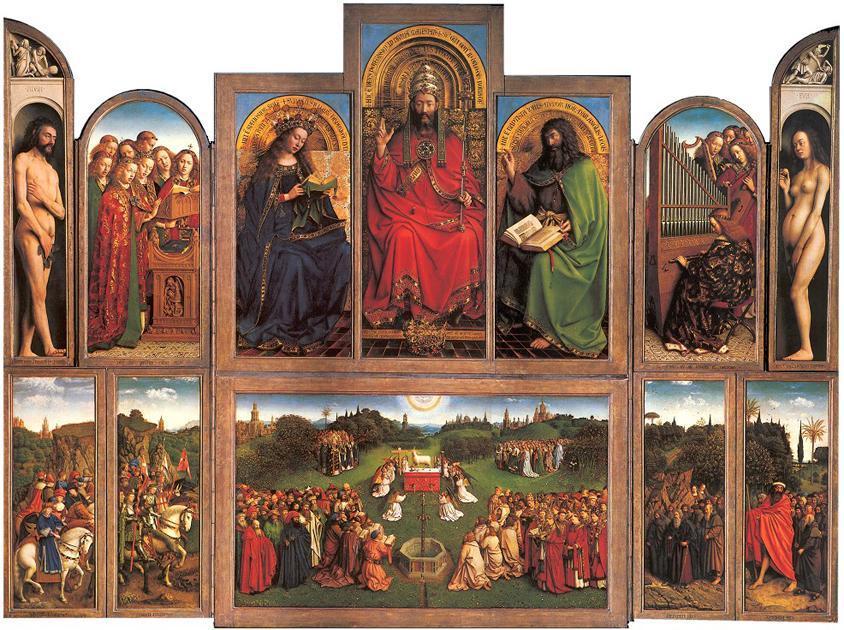Treasure-hunting Belgians warned to keep pickaxes away after claim lost masterpiece hidden beneath street
‘Do not go to the shopping street with a shovel or spade,’ says Ghent’s mayor

Treasure hunters have been urged not to dig up the cobbled streets of Ghent in Belgium after an armchair detective claimed to have cracked a code revealing the location of a stolen masterpiece.
Engineer Gino Marchal announced on Friday he had solved a riddle, left by the thief, behind the disappearance of one of the 12 panels of the 15th century painting Adoration of the Mystic Lamb in 1934.
The clue to its location contains just six words and the number 152, but has baffled police and amateur sleuths for decades.
At a press conference in the city hall, Mr Marchal declared that the hiding place is beneath the Kalandeberg square in the centre of the city.
Although cynics have suggested the announcement is merely a publicity stunt to promote a new book by Mr Marchal and youth fiction author Marc de Bel, Ghent’s mayor Daniël Termont said the public prosecutor’s office “takes this theory very seriously”.
“Do not undertake anything yourself,” Mr Termont warned residents, according to Flemish newspaper De Standaard. “Please do not dig any holes on the Kalandeberg.
“That is work for the police and the public prosecutor’s office.”
The Adoration of the Mystic Lamb, also known as the Ghent Altarpiece, has been attributed to the Flemish artists and brothers Hubert and Jan van Eyck.
It was installed at St Bavo Cathedral in Ghent in 1432 and has been described as one of the most influential artworks in history.
Over the centuries the altarpiece has been repeatedly split up, stolen or moved across Europe. It was seized by German forces during the First World War and was returned under the terms of the Versailles Treaty, only to be taken back by the Nazis in 1942 and eventually returned to Ghent with the help of the “Monuments Men” (curators and professors who recovered countless artworks stolen by the Nazis).
Adolf Hitler was never able to admire the complete work, however, as two of the panels, The Just Judges and St John the Baptist, had been stolen from the cathedral in 1934.
In the months after the theft authorities were sent a series of ransom notes demanding one million Belgian francs in cash.
The St John the Baptist panel was recovered during negotiations but the other missing section was never returned.
A few months later a 57 year-old money exchange agent, Arsene Goedertier, died of heart failure shortly after revealing that papers relating to the theft were at his home in Wetteren.
An envelope containing copies of 13 ransom notes was found in his desk, along with an unsent final letter suggesting that the missing panel “rests in a place where neither I nor anybody else can take it away without arousing the attention of the public”.
Conspiracy theories involving the Knights Templars and the Holy Grail have flourished ever since, and several people have claimed to have broken the thief’s secret code.
The new theory is based on the scribbled words left on the final note: oiseau, arte, jean, nina, erpe and fourrure, along with the number 152.
Mr Marchal said he found locations linked to four of the words that were all 152m from a single point on the Kalandeberg. Plotting the routes also spelt out the letters for the name Nina, he claimed.
Further details are outlined in his book The Fourteenth Letter with Marc de Bel, who is more famous as the author of the children’s books The Egg of Uncle Trotter and Master Plume and the Talking Powder.
The masterpiece used as a dartboard
Show all 2Mr De Bel described the case as “one of the great art robberies of all time”, and added: “We are waiting for a call from Steven Spielberg now.”
“This is of great importance for the city and for Flemish art history,” said the mayor of Ghent.
“If this new theory was no more than a stunt to promote a book, I would never have cooperated, and as a city we would not have made our council hall available for a press conference.”
Subscribe to Independent Premium to bookmark this article
Want to bookmark your favourite articles and stories to read or reference later? Start your Independent Premium subscription today.

Join our commenting forum
Join thought-provoking conversations, follow other Independent readers and see their replies